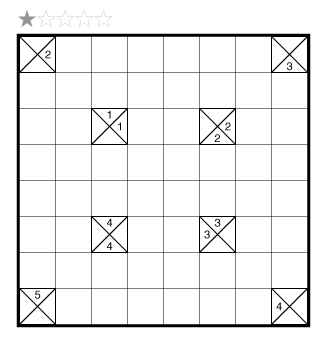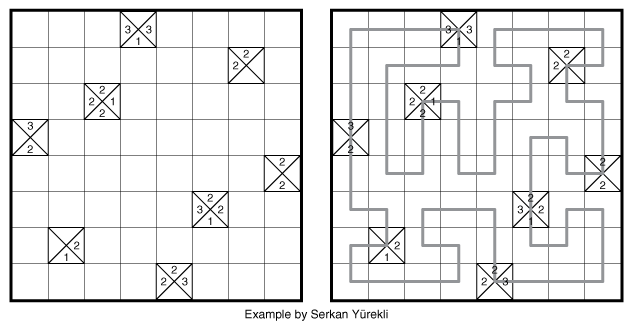Mukkonn Enn by Serkan Yürekli
This style, whose name means “Triangular Numbers” in English and has also been called “Four Directions Loop” elsewhere, was originally created by the Indian team that organized the 2017 World Puzzle Championship as part of an instructionless team round. More Mukkonn Enn will be in our upcoming Loop Variety Collection 2.

or solve online (using our beta test of Penpa-Edit tools in default linex mode where left-click+drag draws line and right click marks X’s)
Theme: Sequences
Author/Opus: This is the 386th puzzle from our managing editor Serkan Yürekli.
Rules: Draw a single, non-intersecting loop that passes through the center of all cells, including clue cells; the loop may either go straight through or turn at each clue. Each clue cell is divided into four sections; if a number is present in a section and the loop travels in that direction, then the number represents the length of the straight loop segment in that direction, measured from the clue cell to the cell where the loop turns. If the loop does not travel in that direction, then the number means nothing.
Also see this example:

Difficulty: 1 star
Time Standards (highlight to view): Grandmaster = 0:45, Master = 1:00, Expert = 2:00
Solution: PDF and solving video.
Note: Follow this link for other Loop/Path puzzles. More Mukkonn Enn puzzles are in the book Loop Variety Collection 2.

What language does “Mukkonn Enn” come from?
Dave: A romanization of Tamil is my understanding.
I tried to solve this soon after waking up and couldn’t figure it out. Put it off until later, and now I realized I missed the “all cells” part of the rules 😛
Cool puzzle, I always enjoy seeing new styles.
@sudgy: The “all cells” constraint is actually fairly common among all loop styles, although interestingly none of GMPuzzles’ “evergreen” styles have this constraint.
I like this puzzle
Interesting genre, I look forward to seeing some harder ones! btw I’d strike “the loop may either go straight through or turn at each clue” from the rules; in general I would not include the *absence* of constraints unless those constraints are sufficiently common that readers might falsely assume their presence, and I don’t think this one is? (similarly, you would never add to the rules “the loop does not need to turn at least once between each pair of clues”, even though it’s a true statement)
This is a fair point and something we’ll review as we continue to improve these rules over time. While we’ve started closer to what the author suggested, clarifying the loop goes through all cells including clue cells is enough.
1:35 Nice !